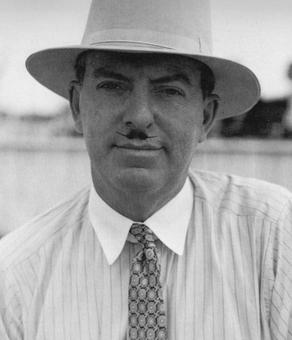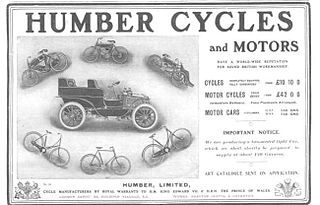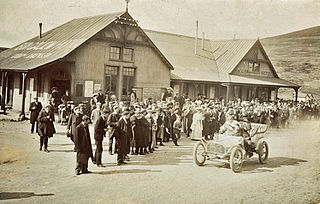This article needs additional citations for verification .(July 2013) |
The Armadale was an English automobile manufactured from 1906 to 1907 by Armadale Motors Ltd, Northwood, Middlesex, then Northwood Motor & Engineering Works, also of Northwood.
This article needs additional citations for verification .(July 2013) |
The Armadale was an English automobile manufactured from 1906 to 1907 by Armadale Motors Ltd, Northwood, Middlesex, then Northwood Motor & Engineering Works, also of Northwood.
Initially called the Toboggan, the Armadale Tri-car, so-called the "perfect little three-wheeler" featured infinitely variable friction drive and a pressed steel chassis, unusual in a tricar. It used either a one-cylinder Aster or a 2-cylinder Fafnir engine.
In 1906, the company listed a conventional 4-wheeler with a 16 hp 4-cylinder engine.
An Armadale car, owned or driven by A.C. Godwin Smith, was entered in the Tourist Trophy Race in the Isle of Man on 27 September 1906, but it did not start. [1]

The Isle of Man TT or Tourist Trophy races are an annual motorcycle racing event run on the Isle of Man in May and June of most years since its inaugural race in 1907. The event begins on the UK Spring Bank Holiday at the end of May and runs for thirteen days. It is often called one of the most dangerous racing events in the world as many competitors have died.

A sports car is a car designed with an emphasis on dynamic performance, such as handling, acceleration, top speed, the thrill of driving, and racing capability. Sports cars originated in Europe in early 1902 and are currently produced by many manufacturers around the world.

D. Napier & Son Limited was a British engineering company best known for its luxury motor cars in the Edwardian era and for its aero engines throughout the early to mid-20th century.

The Acme was a make of American automobiles made in Reading, Pennsylvania from 1903 to 1911. They were the successor of the Reber which was made from 1902 to 1903 by Reber Manufacturing.

Singer Motors Limited was a British motor vehicle manufacturing business, originally a bicycle manufacturer founded as Singer & Co by George Singer, in 1874 in Coventry, England. Singer & Co's bicycle manufacture continued. From 1901 George Singer's Singer Motor Co made cars and commercial vehicles.

Delage is a French luxury automobile and racecar company founded in 1905 by Louis Delâge in Levallois-Perret near Paris; it was acquired by Delahaye in 1935 and ceased operation in 1953.
Dirt track racing is a form of motorsport held on clay or dirt surfaced oval race tracks often used for thoroughbred horse racing. Dirt track racing started in the United States before World War I and became widespread during the 1920s and 1930s using both automobiles and motorcycles. Two different types of race cars dominate — open wheel racers in the Northeast and West and stock cars in the Midwest and South. While open wheel race cars are purpose-built racing vehicles, stock cars can be either purpose-built race cars or street vehicles that have been modified to varying degrees. There are hundreds of local and regional racetracks throughout the nation. The sport is also popular in Australia, New Zealand, Canada, South Africa and the United Kingdom.

Harold Arminius Miller, commonly called Harry, was an American race car designer and builder who was most active in the 1920s and 1930s. Griffith Borgeson called him "the greatest creative figure in the history of the American racing car". Cars built by Miller won the Indianapolis 500 nine times, and other cars using his engines won three more. Millers accounted for 83% of the Indy 500 fields between 1923 and 1928.

The Knox Automobile Company was a manufacturer of automobiles in Springfield, Massachusetts, United States, between 1900 and 1914. Knox also built trucks and farm tractors until 1924. They are notable for building the very first modern fire engine in 1905, and the first American vehicle with hydraulic brakes, in 1915.

St. Louis Motor Carriage Company was a manufacturer of automobiles at 1211–13 North Vandeventer Avenue in St. Louis, Missouri, founded by George Preston Dorris and John L. French in 1898, with French taking charge of marketing and Dorris heading engineering and production. St. Louis Motor Carriage was the first of many St. Louis automakers and produced automobiles from 1899 to 1907.

Elva was a sports and racing car manufacturing company based in Bexhill, then Hastings and Rye, East Sussex, United Kingdom. The company was founded in 1955 by Frank G. Nichols. The name comes from the French phrase elle va.
The 1920 Isle of Man TT races was the first races to take place following the end of World War I. Official practice sessions started on 31 May with the races taking place on 15 and 17 June 1920.

Diatto was an Italian manufacturing company founded in 1835 in Turin by Guglielmo Diatto (1804–1864) to make 'carriages for wealthy customers'. In 1874 Guglielmo’s sons, Giovanni and Battista Diatto, began building railway carriages for Compagnie Internationale des Wagons-Lits and the Orient Express. In 1905 Guglielmo's grandsons, Vittorio and Pietro Diatto, began Diatto-Clément, a cooperative venture making motor-vehicles under license from French manufacturer Clément-Bayard owned by industrialist Adolphe Clément-Bayard. By 1909 they had full ownership of 'Autocostruzioni Diatto' and began developing their own motor-vehicles and exporting them worldwide.
The St John's Short Course was a road-racing street circuit used for the Isle of Man TT held between 1907 and 1910.

Humber Limited was a pioneering British motorcycle manufacturer. Humber produced the first practical motorcycle made in Britain by fitting one of their Humber bicycles with an E. J. Pennington two-horsepower motor in 1896.

The Jackson Automobile Company was an American Brass Era automobile manufacturer located in and named for Jackson, Michigan. The company produced the Jackson from 1903 to 1923, the 1903 Jaxon steam car and the 1904 Orlo.

The 1905 International Tourist Trophy was an automobile motor race held on 14 September 1905 on closed public roads along the Highroads Course on the Isle of Man. It was organised by the Automobile Club of Great Britain and Ireland, and was the first time that what became known as the RAC Tourist Trophy was awarded. The race lasted over six hours and was won by John Napier, driving an Arrol-Johnston. Percy Northey finished second in a Rolls-Royce, while the Vinot-Deguingand driver Norman Littlejohn was third.
The Mildren name was used on a series of racing vehicles constructed for, or acquired by, Australian racing team owner Alec Mildren during the 1960s and early 1970s.

The 1921 S.T.D. 'Works' Grand Prix chassis was built to the three-litre and minimum weight of 800 kilogrammes formula for that year's Indianapolis 500 and French Grand Prix de l’A.C.F. These team cars were modified by the Sunbeam Experimental department in Wolverhampton for the 1922 Isle of Man Tourist Trophy, which was won by one of the cars. A few months later, and with 1916 4.9-litre engines, two of the T.T. cars competed in the Coppa Florio, Sicily and gained second and fourth position.
Leo William Goossen was a draftsman, mechanical engineer and automobile designer. He is known for his work with Harry Miller and his long involvement in the design and ongoing development of the four-cylinder Offenhauser ("Offy") racing engine.